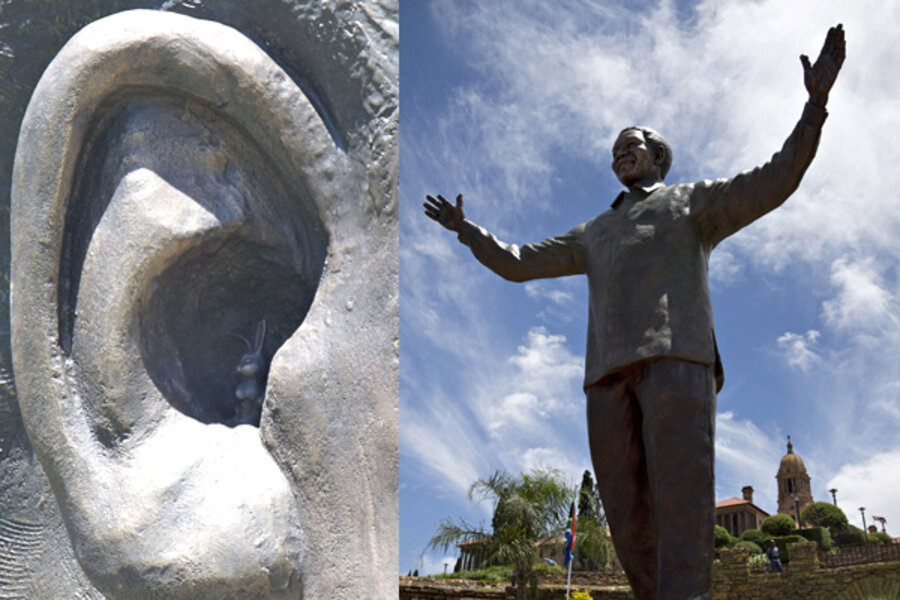Sculptors ordered to pull rabbit out of Mandela's ear
Loading...
| Johannesburg, South Africa
The South African government says that Nelson Mandela's ear is no place for a rabbit.
South Africa's Department of Arts and Culture ordered two sculptors to remove a tiny bronze rabbit they created to sit in the ear of their statue of Nelson Mandela. The statue was recently unveiled amid fanfare outside the Union Buildings in Pretoria, South Africa's capital.
Artists Andre Prinsloo and Ruhan Janse van Vuuren secretly added the rabbit as a "small trademark" of their work, adding that the government had refused to let them engrave their signatures on the trousers of the 29-foot bronze-plated statue.
But the department failed to see any funny side to the independent "signature." Authorities said the rabbit was out of keeping with the message the statue was meant to convey.
“It is unfortunate that the sculptors ... chose to place an object in the statue without the knowledge of those who commissioned them,” Arts and Culture Minister Paul Mashatile said in a statement.
A spokesman for the department later confirmed that they had ordered the removal of the rabbit to "restore dignity back to the statue."
"We don't think it's appropriate because Nelson Mandela never had a rabbit on his ear," Mogomotsi Mogodiri, the spokesman for the Department of Arts and Culture, told journalists. "We'd want people to see that statue as a symbol of hope, not about something like a rabbit."
The statue of Nelson Rolihlala Mandela was unveiled outside the majestic headquarters of South Africa’s government, which sits on an escarpment overlooking the capital, Pretoria, shortly after his death last month.
The two artists said the rabbit also referred to the very tight deadline they worked under in completing the Mandela monument, since the word “haas,” meaning rabbit in Afrikaans, also referred to the idea of haste.
"The time factor was big and at times we had to work hard," Mr. Prinsloo told the Afrikaans-language Beeld newspaper, adding that the "small symbol" was hidden in the ear and it did not take anything away from the statue.
"You need a long lens or binoculars to see it," he said. "During the molding process a lot of people had seen the statue up close and nobody noticed it."
Dali Tambo, the son of the late liberation struggle icon Oliver Tambo, who commissioned the work on behalf of the department, described the rabbit signature as a "senseless prank."
"It is regrettable that the artists chose this way of expressing their opinion about not signing the sculpture, and that they felt it should be kept secret from their clients,” he said.
Prinsloo told the local Mail & Guardian newspaper that he has had no direct contact with the department since the rabbit’s presence was discovered.
"I honestly don't know if we have been forgiven because I just read about it in the newspapers, and on the Internet," he said. "I am sorry that such a small thing could cause such a palava [hassle or disturbance]. It was just a hidden signature."
Mr. Mashatile told the same paper that no real harm was done: "They have since apologized for this and for any offence that may have been given to those who felt their actions disrespected the memory and legacy of Tata Mandela. We accept their apology and that their intentions were honorable,” he said.
Some Twitter users are keen to see the rabbit stay, and are tweeting their support under the hashtag #SaveTheRabbit.
One, @wianesterhuizen, wrote:
Another, @unsuetable, added:







